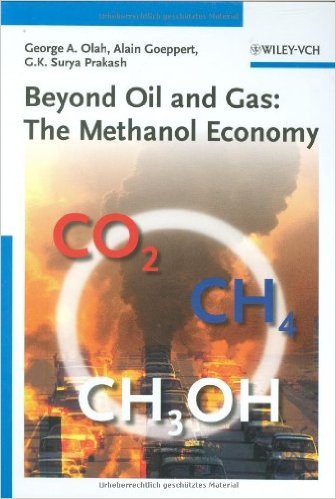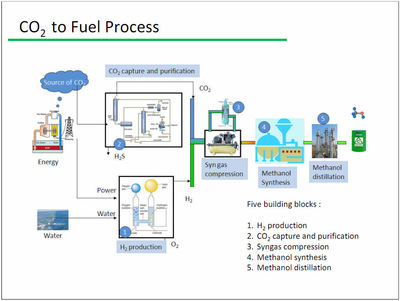Methanol Made From Coal For Liquid Auto Fuel Has Grown Rapidly In China Since 2000 (But Not In USA) - The Methanol Economy
LEARN MORE: 1997 Ford Methanol Taurus Costs Less than Gas (Published Aug. 27, 1996)
LEARN MORE: Methanol News Archive
LEARN MORE: When All American Drivers Use Non-Exportable Domestic Fuel, MPG Hysteria Will Go Away
Washington DC - February 23, 2017: China is the global leader in methanol use and has recently expanded methanol production capacity. Since the early 2000s, China’s methanol consumption in fuel products has risen sharply and is estimated to have been more than 500,000 barrels per day (b/d) in 2016.
EIA commissioned a study from Argus Media group to better understand China’s consumption of methanol and its derivatives. The estimates developed in the study have now been incorporated into EIA’s historical data and forecasts of petroleum and other liquids consumption in China.

Methanol, like ethanol, is an alcohol with inherent issues such as its solubility in water and corrosiveness. Methanol or its derivative products can be added to fuels such as gasoline and liquefied petroleum gases (LPG). Similar to how ethanol is currently blended into motor gasoline in the United States, methanol is blended into gasoline in China.
Most of China’s methanol supply is from domestic production. About two-thirds of China’s methanol feedstock is produced from coal and the remainder from coking gas (a by-product of steel production) and natural gas. China has abundant coal resources, and for more than a decade the country has increased its capacity to manufacture methanol using coal as a feedstock. Smaller amounts of China’s methanol supply are imported from the Middle East, Southeast Asia, South America, and the United States.
Methanol is a clean-burning, high-octane fuel component, as the oxygen present in methanol aids in more complete fuel combustion. Blending methanol with gasoline allows refiners to extend China’s gasoline supply and increase the octane level of its gasoline. However, methanol has only one-half the energy per unit of volume as gasoline and requires more fuel consumption on a volumetric basis to provide the same amount of energy.
China’s largest city, Shanghai, and 13 of China’s 23 provinces have approved local standards for methanol blends ranging from 5% to 100% methanol. China has a national quality standard for methanol blends of 85%, and a national standard for a 15% blend of methanol in gasoline is pending approval by the government.
A methanol derivative known as methyl tertiary butyl ether (MTBE) is also blended into gasoline in China to increase octane levels. Consumption of MTBE and other derivatives in China was estimated at 230,000 b/d in 2016. Starting in the 1990s, MTBE was used as an oxygenate and octane enhancer in reformulated gasoline sold in the United States, with domestic production exceeding 200,000 b/d from 1998 to 2002. However, concerns over groundwater contamination led an increasing number of states to ban it. Following enactment of provisions of the Energy Policy Act of 2005 that were interpreted as reducing or eliminating legal defenses available to MTBE blenders, its use was soon phased out in the United States.
Methanol can also be converted directly to gasoline, and in China this conversion occurs much less often than the blending of methanol or its derivatives into gasoline. China built its first methanol-to-gasoline (MTG) plant in 2010, and since then, another 10 MTG plants have come online. MTG units involve high capital costs and are only cost-competitive when oil prices are high. Lower oil prices since late 2014 have reduced China’s MTG plant operating rates and have created uncertainty for investment in new MTG plants.
For blending into liquefied petroleum gases such as propane, China uses methanol to create a derivative known as dimethyl ether (DME), a compound that has the same molecular formula as ethanol but a different chemical structure. Despite an official ban on the use of DME in LPG cylinders, some DME has been blended into LPG delivered to China's residential sector. Over the past two years, though, two factors—stronger enforcement of the DME ban and lower price competitiveness of DME relative to LPG—have reduced the level of DME blending.
MIT TECHNOLOGY REVIEW
Beyond Oil and Gas; The Methanol Economy
 |
The Methanol Economy
By Kevin Bullis
MIT Technology Review
March 2, 2006
Forget about the hydrogen economy. Methanol is the key to weaning the world off oil. George Olah tells us how to do it.
The hydrogen economy – with its vision of gas-guzzling engines replaced by hydrogen fuel cells that produce water instead of smog and greenhouse gases – is a big mistake, according to George Olah, winner of the 1994 Nobel Prize in chemistry.
Olah, whose research in the chemistry of hydrocarbons has led to high-octane fuels and more easily degradable hydrocarbons, is now director of the Loker Hydrocarbon Research Institute at the University of Southern California. He argues that storing energy in the form of methanol, not hydrogen, could end our dependence on fossil fuels and transform carbon dioxide from a global-warming liability into an essential raw material for a methanol-based economy. Olah lays out his plan in a new book, Beyond Oil and Gas: The Methanol Economy, published last week by Wiley-VCH.
Technology Review: Why methanol?
George Olah: Methanol in its own right is an excellent fuel. You can mix it into gasoline – it’s a much better fuel than ethanol. And we have developed a methanol fuel cell.
Methanol is a very simple chemical that can be made in a very efficient way. It is just one oxygen atom inserted into methane, the basal component of natural gas; but methanol is a liquid material which is easily stored, transported, and used.
TR: What’s wrong with hydrogen fuel cells?
GO: Even today you could put a pump dispensing methanol at every gasoline station. You can dispense it very well without any [new] infrastructure. For hydrogen, there is no infrastructure. To establish a hydrogen infrastructure is an enormously costly and questionable thing. Hydrogen is a very volatile gas, and there is no way to store or handle it in any significant amount without going to high pressure.
TR: But methanol is a way of storing energy, not a source of energy like gasoline. Where will the energy come from?
GO: The beauty is we can take any source of energy. Whether it’s from burning fossil fuels, from atomic plants, from wind, solar, or whatever. What we are saying is it makes a lot better sense, instead of trying to store and transport energy as very volatile hydrogen gas, to convert it into a convenient liquid. And there’s a fringe benefit: you really mitigate carbon dioxide in the atmosphere.
TR: How do you make methanol?
GO: One approach is to produce methanol by converting still-existing huge reserves of natural gas, but in entirely different, new ways. Today, methanol is made exclusively from natural gas. Natural gas is incompletely burned, or converted, to synthesis gas, which can then be put together into methanol. Now we have developed ways to completely eliminate the use of synthesis gas.
The second approach involves carbon dioxide. We were co-inventors of the direct methanol fuel cell. This fuel cell uses methanol and produces CO2 and water. It occurred to us that maybe you could reverse the process. And, indeed, you can take carbon dioxide and water, and if you have electric power, you can chemically reduce it into methanol.
So the second leg of our methanol economy approach is to regenerate or recycle carbon dioxide initially from sources where it is present in high concentrations, like flue gases from a power plant burning natural gas. But eventually, and this won’t come overnight, we could just take out carbon dioxide from air.
TR: This would help address the problem of carbon dioxide as a greenhouse gas, wouldn’t it?
GO: Sequestration [of carbon dioxide] is our [government’s] official policy and this is what everybody is swearing by. They say that you stick carbon dioxide down into the earth and at the bottom of the sea, and you solve the problem. [But] how long will it stay down there? Carbon dioxide is a very volatile material. Under the best of conditions it eventually will seep up. Our approach is very different: we simply say that if we need to dispose of carbon dioxide, we need to capture it – why not use it as a chemical raw material? In other words, recycle it.
TR: We’ve heard a lot lately about replacing gasoline with ethanol from biological sources and developing better batteries for super-efficient hybrid cars. Do these have a place in a methanol economy?
GO: I think we should explore all possibilities. There is no silver bullet. There is no single solution. I sincerely believe, however, that if you look really impartially, but hard-nosed, at the figures, the needs are so enormous that biological sources per se won’t solve them. The president mentioned making ethanol from cellulosic materials. In principle it’s possible, but it’s a very difficult, undeveloped, and, in my mind, unrealistic technology. Batteries, sure, we should try to find better batteries. But realistically today, fuel cells are a lot more convenient than any battery.
TR: What steps need to be taken now to move toward a methanol economy?
GO: I’m a great believer that technological development is done by major companies. ExxonMobil certainly has some means to do it. The only trouble is that so far they are not coming up with any reasonable solution. Basically, I don’t think they like [the methanol economy] very much. If you sit on a large supply of oil and gas, on which you make enormous profits, or if you are an Arab country that has great supplies and great wealth, you wouldn’t welcome some crazy guy who comes up and says that mankind can have an ultimate solution which would not be dependent, anymore, on what nature put under your soil.
If this methanol economy makes sense, and I think it does, there is not necessarily a monopoly any more for oil companies. Big chemical companies could equally well do this, or even better. But there is also a need for politicians and the public to say that they want to explore reasonable solutions.
TR: How urgent is the problem?
GO: Man began to use coal on a massive scale during the Industrial Revolution, which was, what, 250 years ago. And we are already, to a very significant degree, depleting what nature gave us. Now, I’m not saying we’ll run out of it overnight, but we need to think about how we manage our problems now and how we will manage in the future.
You see natural gas getting in short supply, and we import liquefied natural gas. There are many natural gas sources – Nigeria, the United Arab Emirates, the North Sea, and so on. The energy content of a single LNG tanker is equivalent to a medium-sized hydrogen bomb. Bad guys are trying to blow up refineries now, and a big tanker is a very inviting target. Who can guarantee that some crazy terrorist won’t blow up an LNG tanker? I think a realistic solution is, again, to convert natural gas, as efficiently as we can, into a safe liquid product, like methanol.
All people believe that what they are doing has some importance; but this [methanol research] is, in my mind, the most important thing I ever did in my career, and it has serious implications for society.



